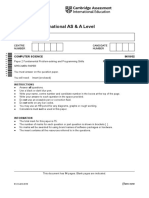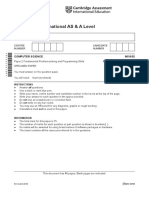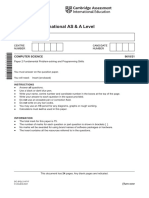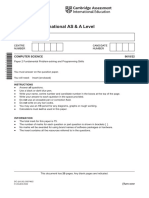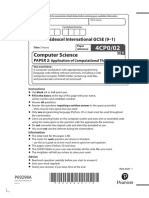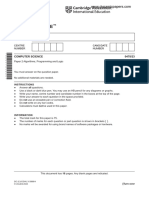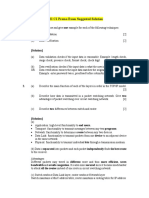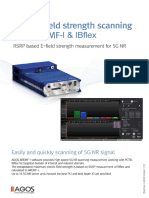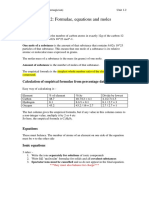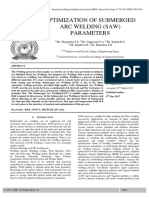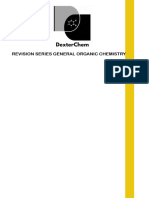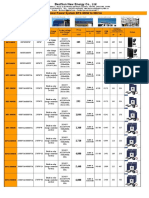As Compsci Mock p2
Uploaded by
Ahmad JailbreakAs Compsci Mock p2
Uploaded by
Ahmad JailbreakRefer to the insert for the list of pseudocode functions and operators.
1 (a) (i) Complete the following table by giving the appropriate data type in each case.
Variable Example data value Data type
Name "Catherine"
Index 100
Modified FALSE
Holiday 25/12/2020
[4]
(ii) Evaluate each expression in the following table by using the initial data values shown in
part (a)(i).
Expression Evaluates to
Modified OR Index > 100
LENGTH("Student: " & Name)
INT(Index + 2.9)
MID(Name, 1, 3)
[4]
(b) Each pseudocode statement in the following table contains an example of selection,
assignment or iteration.
Put one tick (‘✓’) in the appropriate column for each statement.
Statement Selection Assignment Iteration
Index Index + 1
IF Modified = TRUE THEN
ENDWHILE
[3]
9618 Computer Science - Paper 2 1 of 17
2 An algorithm will:
1. prompt and input a sequence of 100 integer values, one at a time
2. sum the positive integers
3. output the result of the sum.
(a) Write pseudocode for the algorithm.
Assume the value zero is neither positive nor negative.
You must declare all variables used in the algorithm.
...................................................................................................................................................
...................................................................................................................................................
...................................................................................................................................................
...................................................................................................................................................
...................................................................................................................................................
...................................................................................................................................................
...................................................................................................................................................
...................................................................................................................................................
...................................................................................................................................................
...................................................................................................................................................
...................................................................................................................................................
...................................................................................................................................................
............................................................................................................................................. [5]
(b) The algorithm requires the use of basic constructs. One of these is sequence.
Identify one other basic construct required by the algorithm and describe how it is used.
Construct ..................................................................................................................................
Use ...........................................................................................................................................
...................................................................................................................................................
[2]
9618 Computer Science - Paper 2 2 of 17
3 A software developer follows a program development life cycle. The life cycle divides the
development process into various stages.
(a) The following table lists some development activities.
Complete the table by writing the name of the life cycle stage for each activity.
Activity Name of life cycle stage
The walkthrough method is used.
An algorithm is implemented in a programming language.
The client is interviewed about problems with the current system.
The program is modified to run on new hardware.
Records and file structures are defined.
[5]
(b) The program contains a validation function.
(i) The function will:
• take an integer value as a parameter
• return TRUE if the value is within the range 24 to 37, inclusive
• otherwise return FALSE.
Complete the table to define a test plan to thoroughly test the operation of the function.
Type of test data Test data value Expected result
Normal 30 TRUE
[4]
(ii) The function is to be tested on its own. When it is shown to work correctly the function
will be combined with other modules and testing will continue.
Identify the type of testing that this represents.
..................................................................................................................................... [1]
9618 Computer Science - Paper 2 3 of 17
4 A program contains six modules with headers as follows:
Pseudocode module header
PROCEDURE Connect()
FUNCTION Activate(H1 : STRING, Code : INTEGER) RETURNS BOOLEAN
FUNCTION Sync(T1 : BOOLEAN, S2 : REAL) RETURNS INTEGER
PROCEDURE Initialise(BYREF ID : INTEGER, BYVAL CC : INTEGER)
FUNCTION Reset(RA : STRING) RETURNS INTEGER
FUNCTION Enable(SA : INTEGER) RETURNS BOOLEAN
Module Connect() will call either Activate() or Sync(). This is decided at run-time.
(a) Complete the structure chart for these modules.
Connect
T1
[5]
(b) Explain the meaning of the curved arrow symbol used in the diagram in part (a).
...................................................................................................................................................
............................................................................................................................................. [2]
9618 Computer Science - Paper 2 4 of 17
5 An algorithm has three steps. It will:
1. repeatedly input a pair of numeric values A and B
2. count the number of pairs that are input until A has been greater than B 10 times
3. output the number of pairs that were input.
(a) Complete the program flowchart.
START
INPUT A, B
Yes
No
END
[5]
9618 Computer Science - Paper 2 5 of 17
6 A shop sells sandwiches and snacks. The owner chooses a ‘daily special’ sandwich which is
displayed on a board outside the shop. Each ‘daily special’ has two different fillings and is made
with one type of bread.
The owner wants a program to randomly choose the ‘daily special’ sandwich.
The program designer decides to store the possible sandwich fillings in a 1D array of type string.
The array is declared in pseudocode as follows:
DECLARE Filling : ARRAY [1:35] OF STRING
Each element contains the name of one filling.
An example of the first five elements is as follows:
Index Element value
1 "Cheese"
2 "Onion"
3 "Salmon"
4 "Anchovies"
5 "Peanut Butter"
A second 1D array stores the possible bread used:
DECLARE Bread : ARRAY [1:10] OF STRING
Each element contains the name of one type of bread.
An example of the first three elements is as follows:
Index Element value
1 "White"
2 "Brown"
3 "Pitta"
Both arrays may contain unused elements. The value of these will be an empty string and they
may occur anywhere in each array.
A procedure Special() will output a message giving the ‘daily special’ sandwich made from two
randomly selected different fillings and one randomly selected bread.
Unused array elements must not be used when creating the ‘daily special’ sandwich.
Using the above examples, the output could be:
"The daily special is Cheese and Onion on Brown bread."
9618 Computer Science - Paper 2 6 of 17
(a) Complete the pseudocode for the procedure Special().
Assume that both arrays are global.
PROCEDURE Special()
...................................................................................................................................................
...................................................................................................................................................
...................................................................................................................................................
...................................................................................................................................................
...................................................................................................................................................
...................................................................................................................................................
...................................................................................................................................................
...................................................................................................................................................
...................................................................................................................................................
...................................................................................................................................................
...................................................................................................................................................
...................................................................................................................................................
...................................................................................................................................................
...................................................................................................................................................
...................................................................................................................................................
...................................................................................................................................................
...................................................................................................................................................
...................................................................................................................................................
...................................................................................................................................................
...................................................................................................................................................
...................................................................................................................................................
...................................................................................................................................................
ENDPROCEDURE
[7]
9618 Computer Science - Paper 2 7 of 17
(b) The owner decides that some combinations of fillings do not go well together. For example,
anchovies and peanut butter.
Describe how the design could be changed to prevent certain combinations being selected.
...................................................................................................................................................
...................................................................................................................................................
...................................................................................................................................................
...................................................................................................................................................
...................................................................................................................................................
...................................................................................................................................................
...................................................................................................................................................
............................................................................................................................................. [2]
9618 Computer Science - Paper 2 8 of 17
7 A computer system for a shop stores information about each customer. The items of information
include name and address (both postal and email) together with payment details and order history.
The system also stores the product categories they are interested in and how they would like to be
contacted.
(a) The shop wants to add a program module that will generate emails to be sent to customers
who may be interested in receiving details of new products.
(i) State three items of information that the new module would need. Justify your choice in
each case.
Information ........................................................................................................................
Justification .......................................................................................................................
...........................................................................................................................................
Information ........................................................................................................................
Justification .......................................................................................................................
...........................................................................................................................................
Information ........................................................................................................................
Justification .......................................................................................................................
...........................................................................................................................................
[3]
(ii) Identify two items of customer information that would not be required by the new module.
Justify your choice in each case.
Information ........................................................................................................................
Justification .......................................................................................................................
...........................................................................................................................................
Information ........................................................................................................................
Justification .......................................................................................................................
...........................................................................................................................................
[2]
9618 Computer Science - Paper 2 9 of 17
(b) The program includes a module to validate a Personal Identification Number (PIN). This is
used when customers pay for goods using a bank card.
A state‑transition diagram has been produced for this module.
The table show the inputs, outputs and states for this part of the program:
Current state Input Output Next state
S1 Input PIN S2
S2 Re‑input PIN Display error S2
S2 Cancel Re‑prompt S1
S2 Valid PIN Enable payment S4
S2 Too many tries Block Account S3
Complete the state‑transition diagram to represent the information given in the table.
S2
START
S1
Cancel | Re-prompt
[4]
9618 Computer Science - Paper 2 10 of 17
8 A computer shop assembles computers using items bought from several suppliers. A text file
Stock.txt contains information about each item.
Information for each item is stored as a single line in the Stock.txt file in the format:
<ItemNum><SupplierCode><Description>
Valid item information is as follows:
Format Comment
unique number for each item in the range
ItemNum 4 numeric characters
″0001″ to ″5999″ inclusive
SupplierCode 3 alphabetic characters to identify the supplier of the item
Description a string a minimum of 12 characters
The file is organised in ascending order of ItemNum and does not contain all possible values in
the range.
A programmer has started to define program modules as follows:
Module Description
OnlyAlpha() • called with a parameter of type string
(already written)
• returns TRUE if the string contains only alphabetic characters,
otherwise returns FALSE
CheckInfo() • called with a parameter of type string representing a line of item
information
• checks to see whether the item information in the string is valid
• returns TRUE if the item information is valid, otherwise returns
FALSE
9618 Computer Science - Paper 2 11 of 17
(a) Write pseudocode for module CheckInfo().
Module OnlyAlpha() should be used as part of your solution.
...................................................................................................................................................
...................................................................................................................................................
...................................................................................................................................................
...................................................................................................................................................
...................................................................................................................................................
...................................................................................................................................................
...................................................................................................................................................
...................................................................................................................................................
...................................................................................................................................................
...................................................................................................................................................
...................................................................................................................................................
...................................................................................................................................................
...................................................................................................................................................
...................................................................................................................................................
...................................................................................................................................................
...................................................................................................................................................
...................................................................................................................................................
...................................................................................................................................................
...................................................................................................................................................
...................................................................................................................................................
...................................................................................................................................................
...................................................................................................................................................
...................................................................................................................................................
...................................................................................................................................................
...................................................................................................................................................
...................................................................................................................................................
9618 Computer Science - Paper 2 12 of 17
...................................................................................................................................................
...................................................................................................................................................
...................................................................................................................................................
............................................................................................................................................. [7]
(b) A new module is defined as follows:
Module Description
AddItem() • called with a parameter of type string representing valid information
for a new item that is not currently in the Stock.txt file
• creates a new file NewStock.txt from the contents of the file
Stock.txt and adds the new item information at the appropriate
place in the NewStock.txt file
As a reminder, the file Stock.txt is organised in ascending order of ItemNum and does not
contain all possible values in the range.
Write pseudocode for module AddItem().
...................................................................................................................................................
...................................................................................................................................................
...................................................................................................................................................
...................................................................................................................................................
...................................................................................................................................................
...................................................................................................................................................
...................................................................................................................................................
...................................................................................................................................................
...................................................................................................................................................
...................................................................................................................................................
...................................................................................................................................................
...................................................................................................................................................
...................................................................................................................................................
...................................................................................................................................................
...................................................................................................................................................
...................................................................................................................................................
9618 Computer Science - Paper 2 13 of 17
...................................................................................................................................................
...................................................................................................................................................
...................................................................................................................................................
...................................................................................................................................................
...................................................................................................................................................
...................................................................................................................................................
...................................................................................................................................................
...................................................................................................................................................
...................................................................................................................................................
...................................................................................................................................................
...................................................................................................................................................
...................................................................................................................................................
...................................................................................................................................................
............................................................................................................................................. [7]
(c) The program contains modules SuppExists() and CheckSupplier(). These have been
written but contain errors. These modules are called from several places in the main program
and testing of the main program (integration testing) has had to stop.
Identify a method that can be used to continue testing the main program before the errors in
these modules have been corrected and describe how this would work.
Method ......................................................................................................................................
Description ................................................................................................................................
...................................................................................................................................................
...................................................................................................................................................
...................................................................................................................................................
[3]
9618 Computer Science - Paper 2 14 of 17
Functions
Note: An error will be generated if a function call is not properly formed or if the parameters are of an
incorrect type or an incorrect value.
String and Character Functions
LEFT(ThisString : STRING, x : INTEGER) RETURNS STRING
returns leftmost x characters from ThisString
Example: LEFT("ABCDEFGH", 3) returns "ABC"
RIGHT(ThisString : STRING, x : INTEGER) RETURNS STRING
returns rightmost X characters from ThisString
Example: RIGHT("ABCDEFGH", 3) returns "FGH"
MID(ThisString : STRING, x : INTEGER, y : INTEGER) RETURNS STRING
returns a string of length y starting at position x from ThisString
Example: MID("ABCDEFGH", 2, 3) returns string "BCD"
LENGTH(ThisString : STRING) RETURNS INTEGER
returns the integer value representing the length of string ThisString
Example: LENGTH("Happy Days") returns 10
LCASE(ThisChar : CHAR) RETURNS CHAR
returns the character representing the lower-case equivalent of ThisChar
Alphabetic characters that are not upper case are returned unchanged.
Example: LCASE('W') returns 'w'
UCASE(ThisChar : CHAR) RETURNS CHAR
returns the character representing the upper-case equivalent of ThisChar
Alphabetic characters that are not lower case are returned unchanged.
Example: UCASE('a') returns 'A'
TO_UPPER(ThisString : STRING) RETURNS STRING
returns a string formed by converting all characters of ThisString to upper case.
Example: TO_UPPER("Error 803") returns "ERROR 803"
TO_LOWER(ThisString : STRING) RETURNS STRING
returns a string formed by converting all characters of ThisString to lower case.
Example: TO_LOWER("JIM 803") returns "jim 803"
NUM_TO_STR(x : <datatype1>) RETURNS <datatype2>
returns a string representation of a numeric value.
Note: <datatype1> may be REAL or INTEGER, <datatype2> may be CHAR or STRING
Example: NUM_TO_STR(87.5) returns "87.5"
STR_TO_NUM(x : <datatype1>) RETURNS <datatype2>
returns a numeric representation of a string.
Note: <datatype1> may be CHAR or STRING, <datatype2> may be REAL or INTEGER
Example: STR_TO_NUM("23.45") returns 23.45
9618 Computer Science - Paper 2 15 of 17
String and Character Functions
IS_NUM(ThisString : <datatype>) RETURNS BOOLEAN
returns the value TRUE if ThisString represents a valid numeric value.
Note: <datatype> may be CHAR or STRING
Example: IS_NUM("-12.36") returns TRUE
ASC(ThisChar : CHAR) RETURNS INTEGER
returns an integer value (the ASCII value) of character ThisChar
Example: ASC('A') returns 65, ASC('B') returns 66, etc.
CHR(x : INTEGER) RETURNS CHAR
returns the character whose integer value (the ASCII value) is x
Example: CHR(65) returns 'A', CHR(66) returns 'B', etc.
Numeric Functions
INT(x : REAL) RETURNS INTEGER
returns the integer part of x
Example: INT(27.5415) returns 27
RAND(x : INTEGER) RETURNS REAL
returns a real number in the range 0 to x (not inclusive of x).
Example: RAND(87) could return 35.43
Date Functions
Note: Date format is assumed to be DD/MM/YYYY unless otherwise stated.
DAY(ThisDate : DATE) RETURNS INTEGER
returns the current day number from ThisDate
Example: DAY(04/10/2003) returns 4
MONTH(ThisDate : DATE) RETURNS INTEGER
returns the current month number from ThisDate
Example: MONTH(04/10/2003) returns 10
YEAR(ThisDate : DATE) RETURNS INTEGER
returns the current year number from ThisDate
Example: YEAR(04/10/2003) returns 2003
DAYINDEX(ThisDate : DATE) RETURNS INTEGER
returns the current day index number from ThisDate where Sunday = 1, Monday = 2, etc.
Example: DAYINDEX(12/05/2020) returns 3
SETDATE(Day, Month, Year : INTEGER) RETURNS DATE
returns a variable of type DATE with the value of <Day>/<Month>/<Year>
TODAY() RETURNS DATE
returns a variable of type DATE with the value set to the current date.
9618 Computer Science - Paper 2 16 of 17
Text File Functions
EOF(FileName : STRING) RETURNS BOOLEAN
returns TRUE if there are no more lines to be read from file FileName
Note: The function will generate an error if the file is not already open in READ mode.
Operators
Note: An error will be generated if an operator is used with a value or values of an incorrect type.
Concatenates (joins) two strings
& Example: "Summer" & " " & "Pudding" evaluates to "Summer Pudding"
Note: May also be used to concatenate a CHAR with a STRING
Performs a logical AND on two Boolean values
AND
Example: TRUE AND FALSE evaluates to FALSE
Performs a logical OR on two Boolean values
OR
Example: TRUE OR FALSE evaluates to TRUE
Performs a logical NOT on a Boolean value
NOT
Example: NOT TRUE evaluates to FALSE
Finds the remainder when one number is divided by another
MOD
Example: 10 MOD 3 evaluates to 1
Finds the quotient when one number is divided by another
DIV
Example: 10 DIV 3 evaluates to 3
Comparison Operators
= Used to compare two items of the same type. Returns TRUE if the condition is true,
otherwise returns FALSE
>
Notes:
<
• may be used to compare types REAL and INTEGER
• may be used to compare types CHAR and STRING
>=
• case sensitive when used to compare types CHAR or STRING
• cannot be used to compare two records.
<= Examples:
• "Program" = "program" evaluates to FALSE
<> • count = 4 evaluates to TRUE when variable count contains the value 4
9618 Computer Science - Paper 2 17 of 17
You might also like
- Cambridge International AS & A Level: Computer Science 9618/02No ratings yetCambridge International AS & A Level: Computer Science 9618/0214 pages
- CS Test 1 - Memo Problem - Solving and Design0% (1)CS Test 1 - Memo Problem - Solving and Design7 pages
- Cambridge IGCSE: Computer Science 0478/21No ratings yetCambridge IGCSE: Computer Science 0478/2116 pages
- Cambridge IGCSE: Computer Science 0478/21No ratings yetCambridge IGCSE: Computer Science 0478/2116 pages
- Cambridge International AS & A Level: Computer Science 9618/22No ratings yetCambridge International AS & A Level: Computer Science 9618/2220 pages
- Thursday 25 May 2023 - Afternoon: © OCR 2023 (601/8355/X) DC (ST) 332525/1No ratings yetThursday 25 May 2023 - Afternoon: © OCR 2023 (601/8355/X) DC (ST) 332525/144 pages
- Cambridge IGCSE: Computer Science 0478/23No ratings yetCambridge IGCSE: Computer Science 0478/2316 pages
- Cambridge IGCSE: Computer Science 0478/22No ratings yetCambridge IGCSE: Computer Science 0478/2216 pages
- Computer Science P2 Unsolved 2023-2024No ratings yetComputer Science P2 Unsolved 2023-202415 pages
- 2210 - 02 - Status Basic - Program Design 2024No ratings yet2210 - 02 - Status Basic - Program Design 20246 pages
- Cambridge O Level: Computer Science 2210/23No ratings yetCambridge O Level: Computer Science 2210/2316 pages
- Cambridge IGCSE: Computer Science 0478/23No ratings yetCambridge IGCSE: Computer Science 0478/2316 pages
- Cambridge International AS & A Level: Computer Science 9618/21No ratings yetCambridge International AS & A Level: Computer Science 9618/2120 pages
- Computer Science A Level Pre-Released Material 2016No ratings yetComputer Science A Level Pre-Released Material 20168 pages
- Cambridge International AS & A Level: Computer Science 9618/22No ratings yetCambridge International AS & A Level: Computer Science 9618/2224 pages
- Cambridge International AS & A Level: Computer Science 9618/23No ratings yetCambridge International AS & A Level: Computer Science 9618/2320 pages
- Cambridge International Advanced Subsidiary and Advanced LevelNo ratings yetCambridge International Advanced Subsidiary and Advanced Level16 pages
- Cambridge International AS & A Level: Computer Science 9608/23No ratings yetCambridge International AS & A Level: Computer Science 9608/2320 pages
- June 2023 (v3) QP - Paper 2 CAIE Computer Science IGCSENo ratings yetJune 2023 (v3) QP - Paper 2 CAIE Computer Science IGCSE16 pages
- Duration: Not Set: © Ocr 2023. You May Photocopy This Page. 1 of 35 Created in ExambuilderNo ratings yetDuration: Not Set: © Ocr 2023. You May Photocopy This Page. 1 of 35 Created in Exambuilder35 pages
- Cambridge IGCSE: Computer Science 0478/23No ratings yetCambridge IGCSE: Computer Science 0478/2316 pages
- Cambridge IGCSE: Computer Science 0478/21No ratings yetCambridge IGCSE: Computer Science 0478/2116 pages
- Shear Force and Bending Moments: 5kN 10kN 8kN A C D B ENo ratings yetShear Force and Bending Moments: 5kN 10kN 8kN A C D B E20 pages
- Roy M Broad: Networking Performance: A Study of The Benefits of Business Networking in The West MidlandsNo ratings yetRoy M Broad: Networking Performance: A Study of The Benefits of Business Networking in The West Midlands366 pages
- A Review of Engine Downsizing and Its EffectsNo ratings yetA Review of Engine Downsizing and Its Effects6 pages
- Doleh Sufian ch10 p23 Build A Model PDF FreeNo ratings yetDoleh Sufian ch10 p23 Build A Model PDF Free6 pages
- Nygren Et Al. 2019 Lifelong Learning Formal Non Formal and Informal Learning in The Context of TheNo ratings yetNygren Et Al. 2019 Lifelong Learning Formal Non Formal and Informal Learning in The Context of The12 pages
- Cariology: Presented By-Dr. Neha Sultana Post Graduate Student Department of Conservative Dentistry and EndodonticsNo ratings yetCariology: Presented By-Dr. Neha Sultana Post Graduate Student Department of Conservative Dentistry and Endodontics93 pages
- Types Roof Trusses: Building Technology 3 2012100% (1)Types Roof Trusses: Building Technology 3 201234 pages
- Biochem Molecular Bio Educ - 2023 - Garma - Demystifying Dimensionality Reduction Techniques in The Omics Era ANo ratings yetBiochem Molecular Bio Educ - 2023 - Garma - Demystifying Dimensionality Reduction Techniques in The Omics Era A14 pages
- BPS-300W To 30KVA Solar Power System - BESTSUN Solar 2017No ratings yetBPS-300W To 30KVA Solar Power System - BESTSUN Solar 20175 pages
- SCR As Half Wave Rectifier - Electronic Circuits and Diagram-Electronics Projects and DesignNo ratings yetSCR As Half Wave Rectifier - Electronic Circuits and Diagram-Electronics Projects and Design6 pages

